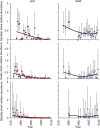Critical assessment and ramifications of a purported marine trophic cascade
- PMID: 26876514
- PMCID: PMC4753470
- DOI: 10.1038/srep20970
Critical assessment and ramifications of a purported marine trophic cascade
Abstract
When identifying potential trophic cascades, it is important to clearly establish the trophic linkages between predators and prey with respect to temporal abundance, demographics, distribution, and diet. In the northwest Atlantic Ocean, the depletion of large coastal sharks was thought to trigger a trophic cascade whereby predation release resulted in increased cownose ray abundance, which then caused increased predation on and subsequent collapse of commercial bivalve stocks. These claims were used to justify the development of a predator-control fishery for cownose rays, the "Save the Bay, Eat a Ray" fishery, to reduce predation on commercial bivalves. A reexamination of data suggests declines in large coastal sharks did not coincide with purported rapid increases in cownose ray abundance. Likewise, the increase in cownose ray abundance did not coincide with declines in commercial bivalves. The lack of temporal correlations coupled with published diet data suggest the purported trophic cascade is lacking the empirical linkages required of a trophic cascade. Furthermore, the life history parameters of cownose rays suggest they have low reproductive potential and their populations are incapable of rapid increases. Hypothesized trophic cascades should be closely scrutinized as spurious conclusions may negatively influence conservation and management decisions.
Figures





References
-
- Paine R. T. Food webs: Linkage, interaction strength and community infrastructure. J. Anim. Ecol. 49, 667–685 (1980).
-
- Polis G. A., Sears A. L. W., Huxel G. R., Strong D. R. & Maron J. When is a trophic cascade a trophic cascade? Trends Ecol. Evol. 15, 473–475 (2000). - PubMed
-
- Menge B. A. Indirect effects in marine rocky intertidal interaction webs: patterns and importance. Ecological Monographs 65, 21–74 (1995).
-
- Pinnegar J. K. et al. Trophic cascades in benthic marine ecosystems: lessons for fisheries and protected-area management. Environmental Conservation 27, 179–200 (2000).
-
- Terborgh J. A. & Estes J. A. Eds. Trophic Cascades: Predators, Prey, and the Changing Dynamics of Nature (Island Press, Washington DC, 2010).
MeSH terms
LinkOut - more resources
Full Text Sources
Other Literature Sources

